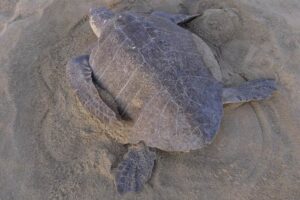Apart from the most obvious – swimming – sea turtles use their flippers for a variety of other things as well. During foraging, their flippers allow them to hold onto prey, swipe it aside to tear off bits or leverage against the substrate again to remove substantial parts of their food. Loggerhead and green turtles have also been observed to use the forelimbs to remove sediment – so essentially to dig up their food.
Additionally, sea turtles use their flippers during mating & nesting. Male turtles hold onto the carapace of the female by hooking on with a large claw on each forelimb. Female turtles move up the beach, pulling with the forelimbs and pushing with the hindflippers. They use the hindlimbs to dig a nest, which is later closed & covered/hidden with the use of all four extremities.


References:
- Fujii JA, McLeish D, Brooks AJ, Gaskell J & Van Houtan KS 2018. Limb-use by foraging marine turtles, an evolutionary perspective. PeerJ 6.
- Spotila JR & Tomillo PS (eds.) 2015. The Leatherback Turtle: Biology and Conservation. Johns Hopkins Press, Maryland, US.
- Wyneken, J. (1996). 7 Sea Turtle Locomotion: Mechanisms, Behavior. The biology of sea turtles, 1, 165.

